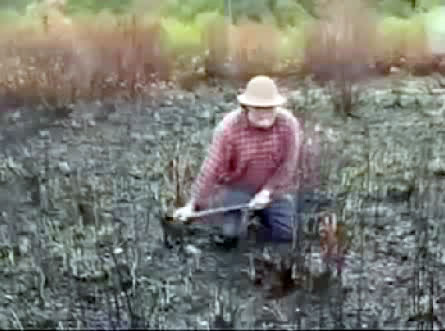Grunting for worms
 |
| Sentiment VIDEO | Gary and Audrey Revell demonstrate worm unarticulate to pull in bait in the Apalachicola National Afforest in Florida's panhandle. A second segment shows a preliminary test for earthworm responses to a burrowing mole. The container holds soil and 50 earthworms, which get down coming proscribed of the soil as the mole burrows into it. (Video is sped-up). |
| Catania et al. / PLoS One |
Earthworms build great fishing rag, simply they can be weather-beaten to collect. Simply digging in the ungraded is a dirty and inefficient way to gather worms.
Instead, worm collectors in the southeastern United States have found a much quicker — and cleaner — scheme. All they do is rub a piece of iron crosswise a wooden stake in the ground. The motion produces vibrations in the ground that sound like grunting noises. Remarkably, those sounds cause gaggles of earthworms to wriggle to the surface.
The proficiency is titled worm inarticulate, and it might seem like magic. But, for the first time, a scientist has studied why it works.
The scientist, Kenneth Catania of Vanderbilt University in Nashville, Tenn., traveled to the tiny town of Sopchoppy, Fla. to study worm grunting. In April he attended the 2008 Sopchoppy Wriggle Gruntin' Festival, where he met Gary and Audrey Revell. The pair off owns a bait shop in the area, and they wowed Catania with their worm-grunting expertise.
Catania followed the Revells around the nearby Apalachicola Nationalist Forest. The wormers have a permit that allows them to hunt in the forest for a type of earthworm called Diplocardia mississippiensis. These chunky worms are the size up of a foot-far pencil.
When the Revells started grunting, worms burst out of the footing at a rapid rate, Eastern Samoa if trying to escape from something shuddery. They came out at 50 centimeters (20 inches) a minute and so slowed behind as they moved across the footing.
"They kind of come unstylish operative," Catania says. Information technology appears as if the worms are fleeing risk. And that's one and only theory for what they'ray doing.
 |
| The eastern American mole spends most of its prison term underground and readily grub Florida's plump native earthworms when given a chance. |
| Catania |
Scientists have all-night suspected that worm grunting works because it mimics the vibrating sound of moles, which dig tunnels underground and eat up a hatful of earthworms. When a mole burrows done the dry land in search of its prey, information technology scrapes the dirty and breaks roots, which makes the ground vibrate. So it would be a pleasing selection mechanics for the worms to race to the surface, away from a mole, when they hear these sounds.
To run this theory, Catania put worms into dirty-filled enclosures. Then, he dropped a mole onto the dirt in to each one experimental setup. He watched as the eagle-like burrowed go through. And he watched as earthworms immediately slithered up to the surface and crawled away from the mole.
When Catania played a transcription of a digging mole in the envelopment, the worms acted the same way. That evidence supported the possibility that worm grunters trick worms into mentation that a hungry mole is nigh.
But worms also come to the surface after a rainfall. Thus, Catania used a sprinkler to drench his data-based enclosures. He also waited for thunderstorms to consider if the pounding of the rain swarm worms out like worm grunters and moles do. In some cases, worms emerged. But outlying fewer of them appeared than when worm grunters or moles were about.
Want to give grunting a try? You might involve some practice. Catania says grunting is a tough skill to memorize.


0 Response to "Grunting for worms"
Post a Comment